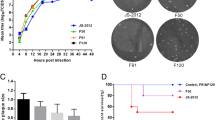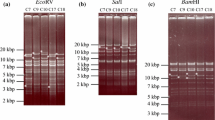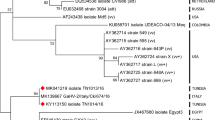Abstract
Attenuation of Gallid herpesvirus-2 (GaHV-2), the causative agent of Marek’s disease, can occur through serial passage of a virulent field isolate in avian embryo fibroblasts. In order to gain a better understanding of the genes involved in attenuation and associate observed changes in phenotype with specific genetic variations, the genomic DNA sequence of a single GaHV-2 virulent strain (648A) was determined at defined passage intervals. Biological characterization of these “interval-isolates” in chickens previously indicated that the ability to induce transient paralysis was lost by passages 40 and the ability to induce persistent neurological disease was lost after passage 80, coincident with the loss of neoplastic lesion formation. Deep sequencing of the interval-isolates allowed for a detailed cataloguing of the mutations that exist within a single passage population and the frequency with which a given mutation occurs across passages. Gross genetic alterations were identified in both novel and well-characterized genes and cis-acting regions involved in replication and cleavage/packaging. Deletions in genes encoding the virulence factors vLipase, vIL8, and RLORF4, as well as a deletion in the promoter of ICP4, appeared between passages 61 and 101. Three mutations in the virus-encoded telomerase which predominated in late passages were also identified. Overall, the frequency of mutations fluctuated greatly during serial passage and few genetic changes were absolute. This indicates that serial passage of GaHV-2 results in the generation of a collection of genomes with limited sequence heterogeneity.




Similar content being viewed by others
References
B.W. Calnek, Pathogenesis of Marek’s disease virus infection, in Current Topics in Microbiology and Immunology, ed. by K. Hirai (Springer, Berlin, 2001), p. 25
R.L. Witter, Marek’s disease virus vaccines-past, present and future (chicken vs. virus-a battle of the centuries), in Current progression Marek’s disease research. Proceedings of the 6th International Symposium on Marek’s disease, ed. by K.A. Schat et al. (American Association of Avian Pathologists, Kennett Square, 2001)
B. Roizman, A.E. Sears, in Fields Virology, ed by B.N. Fields, D.M. Knipe, P.M. Howley (Lippincott-Raven Press, New York, 1996), p. 2231
A.E. Churchill, L.N. Payne, R.C. Chubb, Marek’s disease immunization against Marek’s disease using a live attenuated virus. Lancet 1(7595), 610–611 (1969)
S.R. Pagliusi, M. Teresa Aguado, Efficacy and other milestones for human papillomavirus vaccine introduction. Vaccine 23(5), 569 (2004)
A.M. Prince, Prevention of liver cancer and cirrhosis by vaccines. Clin. Lab. Med. 16(2), 493–505 (1996)
E. Dudnikova et al., Factors influencing the attenuation of serotype 1 Marek’s disease virus by serial cell culture passage and evaluation of attenuated strains for protection and replication. Avian Dis. 53(1), 63–72 (2009)
R.C. Karpathy, G.A. Firth, G.A. Tannock, Derivation, safety and efficacy of a Marek’s disease vaccine developed from an Australian isolate of very virulent Marek’s disease virus. Aust. Vet. J. 80(1–2), 61–66 (2002)
S.J. Spatz et al., Clustering of mutations within the inverted repeat regions of a serially passaged attenuated Gallid herpesvirus type 2 strain. Virus Genes 37(1), 69–80 (2008)
R.L. Witter, K.S. Kreager, Serotype 1 viruses modified by backpassage or insertional mutagenesis: approaching the threshold of vaccine efficacy in Marek’s disease. Avian Dis. 48(4), 768–782 (2004)
R.L. Witter, L.F. Lee, A.M. Fadly, Characteristics of CVI988/Rispens and R2/23, two prototype vaccine strains of serotype 1 Marek’s disease virus. Avian Dis. 39(2), 269–284 (1995)
B.H. Rispens et al., Control of Marek’s disease in the Netherlands. I. Isolation of an avirulent Marek’s disease virus (strain CVI 988) and its use in laboratory vaccination trials. Avian Dis. 16(1), 108–125 (1972)
I. Gimeno et al., Differential attenuation of the induction by Marek’s disease virus of transient paralysis and persistent neurological disease: a model for pathogenesis studies. Avian Pathol. 30(4), 397–409 (2001)
S.J. Spatz, Accumulation of attenuating mutations in varying proportions within a high passage very virulent plus strain of Gallid herpesvirus type 2. Virus Res. 149(2), 135–142 (2010)
R.L. Witter, Increased virulence of Marek’s disease virus field isolates. Avian Dis. 41(1), 149–163 (1997)
C. Sinzger et al., A simple and rapid method for preparation of viral DNA from cell associated cytomegalovirus. J. Virol. Methods 81(1–2), 115–122 (1999)
J.D. Volkening, S.J. Spatz, Purification of DNA from the cell-associated herpesvirus Marek’s disease virus for 454 pyrosequencing using micrococcal nuclease digestion and polyethylene glycol precipitation. J. Virol. Methods 157(1), 55–61 (2009)
M. Zuker, Mfold web server for nucleic acid folding and hybridization prediction. Nucleic Acids Res. 31(13), 3406–3415 (2003)
S.J. Spatz, C.A. Rue, Sequence determination of a mildly virulent strain (CU-2) of Gallid herpesvirus type 2 using 454 pyrosequencing. Virus Genes 36, 478–489 (2008)
E.R. Tulman et al., The genome of a very virulent Marek’s disease virus. J. Virol. 74(17), 7980–7988 (2000)
D. Li et al., Further characterization of the latency-associated transcription unit of Marek’s disease virus. Arch. Virol. 143(2), 295–311 (1998)
R.W. Morgan et al., Marek’s disease virus latency, in Current Topics in Microbiology and Immunology, ed. by K. Harai (Springer, Berlin, 2001), p. 223
S.J. Spatz et al., Comparative full-length sequence analysis of oncogenic and vaccine (Rispens) strains of Marek’s disease virus. J. Gen. Virol. 88(Pt 4), 1080–1096 (2007)
A.M. Levy et al., Characterization of the chromosomal binding sites and dimerization partners of the viral oncoprotein Meq in Marek’s disease virus-transformed T cells. J. Virol. 77(23), 12841–12851 (2003)
J.P. Kamil et al., vLIP, a viral lipase homologue, is a virulence factor of Marek’s disease virus. J. Virol. 79(11), 6984–6996 (2005)
P.L. Cortes, C.J. Cardona, Pathogenesis of a Marek’s disease virus mutant lacking vIL-8 in resistant and susceptible chickens. Avian Dis. 48(1), 50–60 (2004)
X. Cui et al., A Marek’s disease virus vIL-8 deletion mutant has attenuated virulence and confers protection against challenge with a very virulent plus strain. Avian Dis. 49(2), 199–206 (2005)
M.S. Parcells et al., Marek’s disease virus (MDV) encodes an interleukin-8 homolog (vIL-8): characterization of the vIL-8 protein and a vIL-8 deletion mutant MDV. J. Virol. 75(11), 5159–5173 (2001)
K.W. Jarosinski et al., Attenuation of Marek’s disease virus by deletion of open reading frame RLORF4 but not RLORF5a. J. Virol. 79(18), 11647–11659 (2005)
S.J. Spatz, R.F. Silva, Sequence determination of variable regions within the genomes of gallid herpesvirus-2 pathotypes. Arch. Virol. 152(9), 1665–1678 (2007)
F. Peng et al., Isolation and characterization of cDNAs from BamHI-H gene family RNAs associated with the tumorigenicity of Marek’s disease virus. J. Virol. 66(12), 7389–7396 (1992)
L.J. Ross et al., Nucleotide sequence and characterization of the Marek’s disease virus homologue of glycoprotein B of herpes simplex virus. J. Gen. Virol. 70(Pt 7), 1789–1804 (1989)
L. Fragnet et al., The RNA subunit of telomerase is encoded by Marek’s disease virus. J. Virol. 77(10), 5985–5996 (2003)
S.J. Spatz, R.F. Silva, Polymorphisms in the repeat long regions of oncogenic and attenuated pathotypes of Marek’s disease virus 1. Virus Genes 35(1), 41–53 (2007)
A. Abujoub, P.M. Coussens, Development of a sustainable chick cell line infected with Marek’s disease virus. Virology 214(2), 541–549 (1995)
D. Jaikumar, K.M. Read, G.A. Tannock, Adaptation of Marek’s disease virus to the Vero continuous cell line. Vet. Microbiol. 79(1), 75–82 (2001)
X. Li, K.A. Schat, Quail cell lines supporting replication of Marek’s disease virus serotype 1 and 2 and herpesvirus of turkeys. Avian Dis. 48(4), 803–812 (2004)
V. Majerciak et al., Increased virulence of Marek’s disease virus type 1 vaccine strain CV1988 after adaptation to qt35 cells. Acta Virol. 45(2), 101–108 (2001)
T. Onoda et al., Propagation of herpes type virus isolated from chickens with Marek’s disease in Japanese quail embryo fibroblasts. Biken J 13(3), 219–228 (1970)
D. Schumacher et al., Generation of a permanent cell line that supports efficient growth of Marek’s disease virus (MDV) by constitutive expression of MDV glycoprotein E. J. Gen. Virol. 83(Pt 8), 1987–1992 (2002)
K. Osterrieder, J.-F. Vautherot, The genome content of Marek’s disease-like viruses, in Marek’s Disease: An Emerging Problem, ed. by F. Davison, V. Nair (Elsevier, Oxford, 2004)
N. Osterrieder et al., Marek’s disease virus: from miasma to model. Nat. Rev. Microbiol. 4(4), 283–294 (2006)
L. Petherbridge et al., Replication-competent bacterial artificial chromosomes of Marek’s disease virus: novel tools for generation of molecularly defined herpesvirus vaccines. J. Virol. 77(16), 8712–8718 (2003)
K. Jarosinski et al., A herpesvirus ubiquitin-specific protease is critical for efficient T cell lymphoma formation. Proc. Natl. Acad. Sci. USA 104(50), 20025–20030 (2007)
B. Lupiani et al., Marek’s disease virus-encoded Meq gene is involved in transformation of lymphocytes but is dispensable for replication. Proc. Natl. Acad. Sci. USA 101(32), 11815–11820 (2004)
S. Trapp et al., A virus-encoded telomerase RNA promotes malignant T cell lymphomagenesis. J. Exp. Med. 203(5), 1307 (2006)
L. Fragnet, E. Kut, D. Rasschaert, Comparative functional study of the viral telomerase RNA based on natural mutations. J. Biol. Chem. 280(25), 23502–23515 (2005)
B.B. Kaufer et al., Herpesvirus telomerase RNA(vTR)-dependent lymphoma formation does not require interaction of vTR with telomerase reverse transcriptase (TERT). PLoS Pathog. 6(8), e1001073 (2010)
J. Burnside et al., Marek’s disease virus encodes MicroRNAs that map to meq and the latency-associated transcript. J. Virol. 80(17), 8778–8786 (2006)
Y. Yao et al., MicroRNA profile of Marek’s disease virus-transformed T-cell line MSB-1: predominance of virus-encoded microRNAs. J. Virol. 82(8), 4007–4015 (2008)
A.S. Anderson, A. Francesconi, R.W. Morgan, Complete nucleotide sequence of the Marek’s disease virus ICP4 gene. Virology 189(2), 657–667 (1992)
P. O’Hare, G.S. Hayward, Comparison of upstream sequence requirements for positive and negative regulation of a herpes simplex virus immediate-early gene by three virus-encoded trans-acting factors. J. Virol. 61(1), 190–199 (1987)
P. O’Hare, G.S. Hayward, Evidence for a direct role for both the 175,000- and 110,000-molecular-weight immediate-early proteins of herpes simplex virus in the transactivation of delayed-early promoters. J. Virol. 53(3), 751–760 (1985)
I.M. Gimeno et al., Biocharacteristics shared by highly protective vaccines against Marek’s disease. Avian Pathol 33(1), 59–68 (2004)
R. Yunis, K.W. Jarosinski, K.A. Schat, Association between rate of viral genome replication and virulence of Marek’s disease herpesvirus strains. Virology 328(1), 142–150 (2004)
J.W. Balliet et al., Site-directed mutagenesis of large DNA palindromes: construction and in vitro characterization of herpes simplex virus type 1 mutants containing point mutations that eliminate the oriL or oriS initiation function. J. Virol. 79(20), 12783–12797 (2005)
J.W. Balliet, P.A. Schaffer, Point mutations in herpes simplex virus type 1 oriL, but not in oriS, reduce pathogenesis during acute infection of mice and impair reactivation from latency. J. Virol. 80(1), 440–450 (2006)
T.R. Hernandez et al., Mutations in a herpes simplex virus type 1 origin that inhibit interaction with origin-binding protein also inhibit DNA replication. J. Virol. 65(3), 1649–1652 (1991)
D.W. Martin et al., Analysis of the herpes simplex virus type 1 OriS sequence: mapping of functional domains. J. Virol. 65(8), 4359–4369 (1991)
N. Renzette et al., Extensive genome-wide variability of human cytomegalovirus in congenitally infected infants. PLoS Pathog. 7(5), e1001344 (2011)
M.L. Szpara et al., A wide extent of inter-strain diversity in virulent and vaccine strains of alphaherpesviruses. PLoS Pathog. 7(10), e1002282 (2011)
E. Domingo et al., Nucleotide sequence heterogeneity of an RNA phage population. Cell 13(4), 735–744 (1978)
T.F. Ng et al., Discovery of a novel single-stranded DNA virus from a sea turtle fibropapilloma by using viral metagenomics. J. Virol. 83(6), 2500–2509 (2009)
T. Nishizawa et al., Quasispecies of TT virus (TTV) with sequence divergence in hypervariable regions of the capsid protein in chronic TTV infection. J. Virol. 73(11), 9604–9608 (1999)
R.L. Witter, Attenuated revertant serotype 1 Marek’s disease viruses: safety and protective efficacy. Avian Dis. 35(4), 877–891 (1991)
R.F. Silva, S.M. Reddy, B. Lupiani, Expansion of a unique region in the Marek’s disease virus genome occurs concomitantly with attenuation but is not sufficient to cause attenuation. J. Virol. 78(2), 733–740 (2004)
R.F. Silva, R.L. Witter, Genomic expansion of Marek’s disease virus DNA is associated with serial in vitro passage. J. Virol. 54(3), 690–696 (1985)
M. Niikura, J.B. Dodgson, H.H. Cheng, Stability of Marek’s disease virus 132-bp repeats during serial in vitro passages. Arch. Virol. 151(7), 1431–1438 (2006)
L. Petherbridge et al., Oncogenicity of virulent Marek’s disease virus cloned as bacterial artificial chromosomes. J. Virol. 78(23), 13376–13380 (2004)
S.J. Spatz et al., Comparative sequence analysis of a highly oncogenic but horizontal spread-defective clone of Marek’s disease virus. Virus Genes 35(3), 753–766 (2007)
K.W. Jarosinski et al., Horizontal transmission of Marek’s disease virus requires US2, the UL13 protein kinase, and gC. J. Virol. 81(19), 10575–10587 (2007)
A. Barrow, K. Venugopal, Molecular characteristics of very virulent European MDV isolates. Acta Virol. 43(2–3), 90–93 (1999)
S.J. Spatz et al., Genotypic characterization of two bacterial artificial chromosome clones derived from a single DNA source of the very virulent gallid herpesvirus-2 strain C12/130. J. Gen. Virol. 92(Pt 7), 1500–1507 (2011)
Acknowledgments
The authors would like to thank Barbara Riegle of the Avian Disease and Oncology Laboratory for her assistance in the propagation of the virus strains.
Author information
Authors and Affiliations
Corresponding author
Rights and permissions
About this article
Cite this article
Spatz, S.J., Volkening, J.D., Gimeno, I.M. et al. Dynamic equilibrium of Marek’s disease genomes during in vitro serial passage. Virus Genes 45, 526–536 (2012). https://doi.org/10.1007/s11262-012-0792-z
Received:
Accepted:
Published:
Issue Date:
DOI: https://doi.org/10.1007/s11262-012-0792-z




